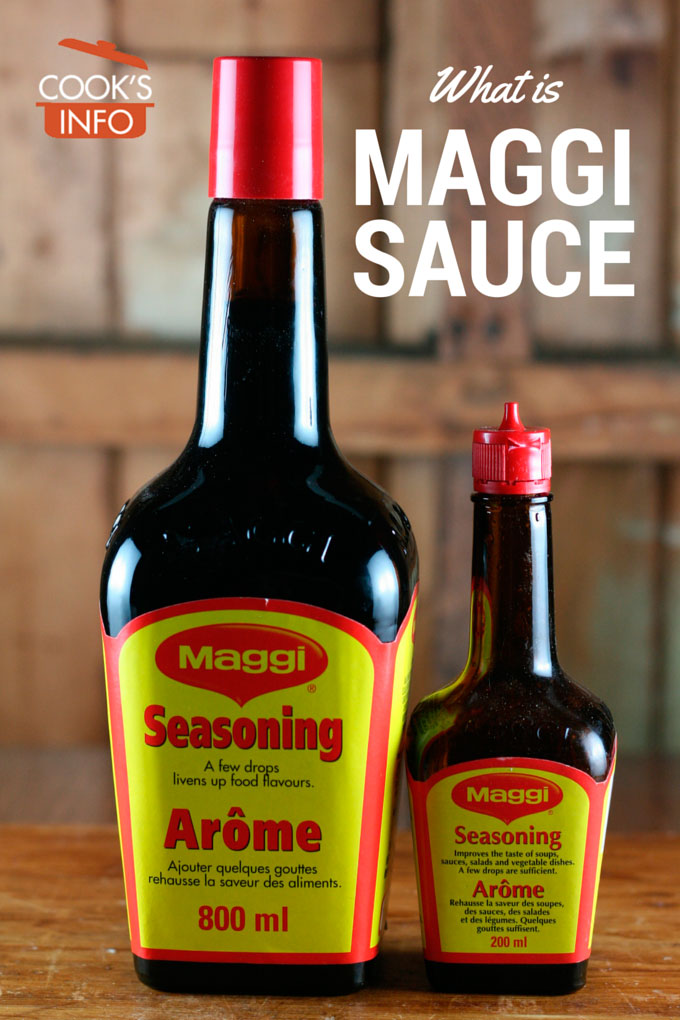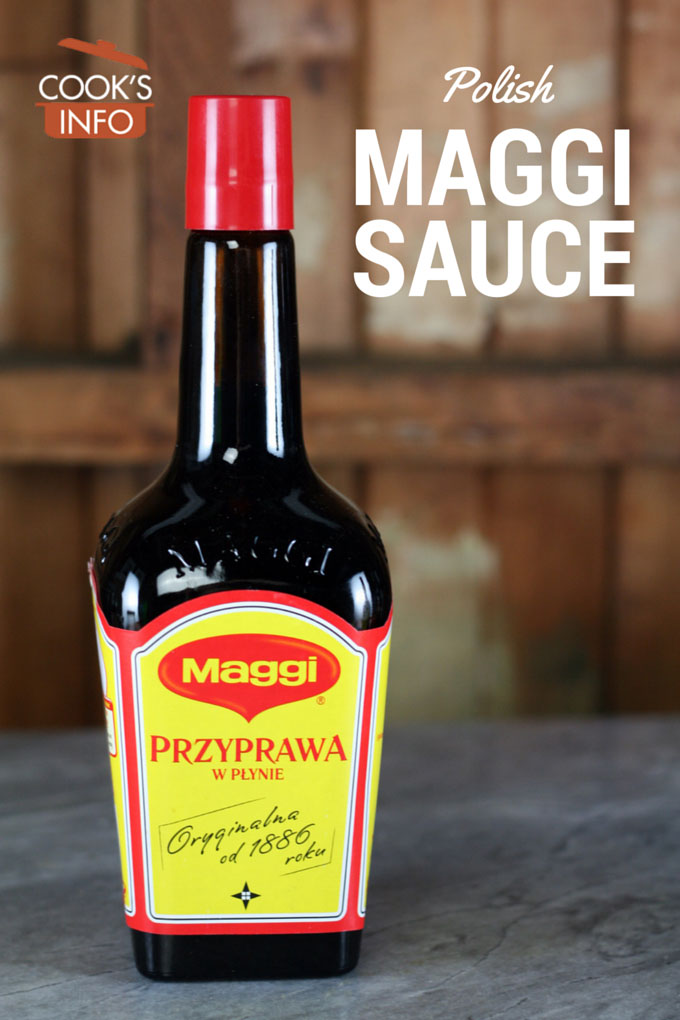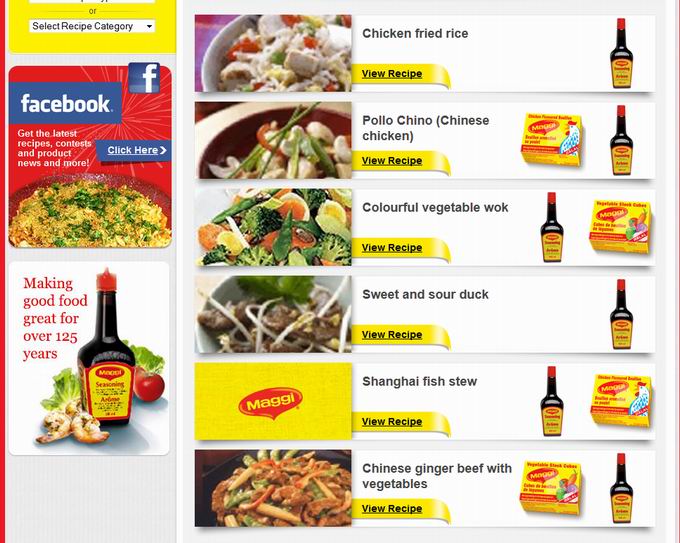
Maggi Seasoning Sauce. © Denzil Green / 2018
Maggi seasoning sauce is a dark, strong, concentrated seasoning sauce produced commercially and sold in bottles.
It is a thin sauce, with the consistency of soy sauce or Worcestershire sauce, which it looks like.
It is a hydrolysed vegetable protein-based sauce used as a substitute for meat flavouring. You just use a few drops at a time.
It is made by the Maggi company. The company makes a very wide range of products, and is known in different parts of the world for different products. Its flagship product, however, remains the sauce after which the company is named. As of 2019, the company is owned by Nestlé.
Versions of Maggi Sauce around the world
Maggi is sold in a dark brown bottle with a yellow label. The colour of the bottle cap changes from country to country: a red cap is used in Switzerland, Germany, Canada and France; a yellow cap is used in China and the Netherlands. Most Americans see the yellow cap.
Different versions of the sauce are made for different parts of the world, adjusting its formulation to meet regional tastes.
The Swiss version of the sauce is the original version.
There is a French version, which some say is the best.
In Mexico, where it’s called Jugo Maggi, there are several versions: plain and spicy (both are more concentrated and darker than European versions), a version called “Maggi Inglesa” (that tastes like Worcestershire sauce), a soy sauce version, and a version with lime in it.
The version made in Manila, Philippines has more garlic in it.
The Polish version is lighter in colour, with a tidge more sourness.
Most North Americans see the Chinese-made version in stores.

Polish Maggi Sauce. © Denzil Green / 2015
Maggi Sauce in Asian Cooking
One of Maggi’s largest and most important markets now is no longer Europe, but rather Asia.
Some feel that Maggi has a particular umami to it which gives it an affinity for Asian-style cooking, particularly Chinese.
The Maggi people noticed the usage, and now even suggest Chinese food recipes to use Maggi in.

Maggi in Asian recipes. Screenshot from Maggi site, 2014.
Cooking Tips
Many people like a few drops of Maggi on fried eggs.
If a soup or stew is tasting “thin” or “bland” to you, and you’ve tried everything to correct the flavour (See: Adjusting the Taste of Dishes), Maggi can often be the “magic bullet” to rescue such soups.
Substitutes
Beef bouillon; soy sauce.
Some people feel that lovage (popular names for which are “Maggikraut” in German and “Maggiplant” in Dutch) can be used in cooking to give a flavour similar to what Maggi sauce would.
Nutrition
The ingredients in the Swiss version are: Water, salt, hydrolysed soya protein, Sodium glutamate, Disodium inosinate (E631), Yeast extract, Citric acid, acetic acid, wheat and “aroma.”
Maggi seasoning sauce may or may not be gluten free: it will depend on which country’s version you have. The version with a red cap sold in Canada lists “wheat gluten” as the third ingredient after water and salt.
Maggi is very high in sodium. But, you are meant to use only a small amount at a time. Always hold off adding salt to a dish until you have added the Maggi and tasted it (unless of course it’s a raw meat dish), to see if you really do feel the dish needs more of a salt taste.
|
Amount
|
||
| Calories |
10
|
|
| Fat |
0 g
|
|
| Saturated |
0 g
|
|
| Trans |
0 g
|
|
| Cholesterol |
0 mg
|
|
| Carbohydrate |
1 g
|
|
| Fibre |
0 g
|
|
| Sugars |
1 g
|
|
| Protein |
2 g
|
|
History Notes
Maggi was created in Switzerland by Julius Maggi (9 October 1846 – 19 October 1912.) In 1872, he took over his father’s food mill and revamped its business model. He started producing a powdered pea and bean soup mix in 1884. In 1886, he introduced Maggi Sauce. In 1897, he incorporated Maggi GmbH in Singen, Germany. Maggi cubes were introduced in 1898. Maggi was acquired by Nestlé in 1947.
Literature & Lore
“Now to tell you a story of a Swiss cooking aid, an old-timer on the chef’s shelf, Maggi by name. Sixty years ago’ on the River Kemp in Switzerland twenty miles from Zurich, a small factory was started to make this cooking produce that soon became famous around the Continent. For half a century the most distinguished culinary artists of Europe have been using this enhancer of flavor to glorify their celebrated dishes. The late Escoffier called it the perfect adjunct to the kitchen.
American hotels and restaurants employing European chefs have used the product for about thirty-five years. Chefs who knew Maggi abroad begged importers to bring in small amounts. Hotel orders so increased during the twenties that one importing firm, quick to see ahead, arranged with the Swiss factory to introduce the product here to the general public. Now home cooks began to learn of its usefulness.
Maggi is principally of vegetable origin, made from a variety of garden crops which grow on the Swiss farms stretching for miles along the Valley Kemp. It is not a spicy sauce of the pour-over type, nor is it intended to change the taste of a food. Its purpose is to emphasize, to intensify, the natural goodness of a dish. No matter how clever you are about cooking, one cannot depend always upon uniform results. Drought, excessive heat, or rain may rob foods of their customary taste, and certain foods are basically low in natural flavors. Here’s an aid to strengthen the taste and bring out the subtle hidden notes, yet never override these with a define character of its own. Used with leftovers, it seems to restore the original freshly cooked flavor. One may use it to enrich the most diverse dishes—soups, sauce, stews, salads, vegetables, and canapes.
As the quality and concentration of the product are unusually high, a few dashes produce results. Try adding it, dash by dash, to an insipid soup’ stirring and tasting until you have it to suit. Note the difference for yourself. This seasoning works its little miracles for the home cook as obligingly as for the 25,000-a-year chef with his tall hat full of tricks.” — Paddleford, Clementine (1898 – 1967). Food Flashes Column. Gourmet Magazine. February 1950.
Language Notes
“Maggi-Würze” (Maggi seasoning sauce). In German,”Flüssigwürze”; in French, “Arome Maggi.”

